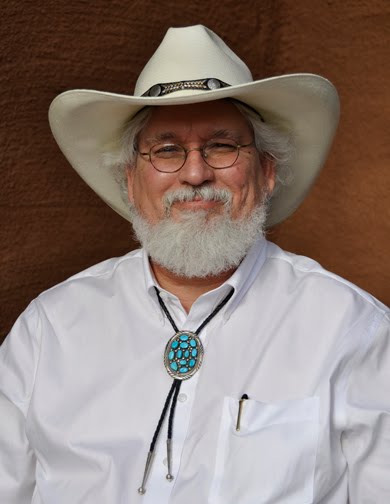
Monday, August 17, 2009
Natay Carroll

Sunday, July 12, 2009
Ray Roanhorse - Nickel Silver Artisan
 Early on Saturday morning a few weeks ago Sandy and I stopped for breakfast at one of Gallup's McDonalds. As we ate we noted a tall Navajo man going table to table offering bowguards (also known as Ketohs) for sale. Bowguards are an ancient leather-based invention designed to protect an archer's wrist from string slap. They are also used as a personal adornment and are frequently worn for ceremorial dress. Although everyone else had waved him on, he found a welcome reception at our table. We learned that he was Ray Roanhorse from Klagetho, Arizona who was taught the craft by his sister Flo. We saw that each bowguard was uniquely stamped and accented with a piece of turquoise from the Sleeping Beauty mine in Arizona. I bought all he had for sale at a price considerably more than he asked.
Early on Saturday morning a few weeks ago Sandy and I stopped for breakfast at one of Gallup's McDonalds. As we ate we noted a tall Navajo man going table to table offering bowguards (also known as Ketohs) for sale. Bowguards are an ancient leather-based invention designed to protect an archer's wrist from string slap. They are also used as a personal adornment and are frequently worn for ceremorial dress. Although everyone else had waved him on, he found a welcome reception at our table. We learned that he was Ray Roanhorse from Klagetho, Arizona who was taught the craft by his sister Flo. We saw that each bowguard was uniquely stamped and accented with a piece of turquoise from the Sleeping Beauty mine in Arizona. I bought all he had for sale at a price considerably more than he asked.I have a particular interest in our regional nickel silversmiths. They work with nickel silver because it is much cheaper to buy than sterling, nonetheless the products are just as labor intensive. Unfortunately, there is very little demand for nickel silver jewelry which sells at a fraction of the cost of sterling based creations. Mr. Roanhorse was pleased that we appreciated his work and that I wanted to ackowledge him as a noteable artist on our internet sites.
Our discovery of Mr. Roanhorse and his work in the midst of our McMuffin feast made for a great start for us on yet another day in Indian Southwest.
Thursday, May 7, 2009
Virgil & Shirley Benn
 Virgil & Shirley Benn have been crafting unique channel inlay products for years. Their names shine along with a few other top notch Zuni jewelry stars. They are particularly well known for their inlays depicting animals such as coyotes, birds, bears, and pumas. They have even done a lion and last I heard were working on a tiger. Their work is accented by expert etching of the stones to give added life to the feathers, fur, and hair of their subjects.
Virgil & Shirley Benn have been crafting unique channel inlay products for years. Their names shine along with a few other top notch Zuni jewelry stars. They are particularly well known for their inlays depicting animals such as coyotes, birds, bears, and pumas. They have even done a lion and last I heard were working on a tiger. Their work is accented by expert etching of the stones to give added life to the feathers, fur, and hair of their subjects.Saturday, April 25, 2009
Butterflies and Caterpillars

Sunday, March 8, 2009
Our National Jewel

*I contracted with a company last week for a commercial website to be used primary for the introduction of individual Native American artists so the story of thier work may be told and thier products placed on world wide display. After the first 50 entries, I plan to publish as the first volume. The fledgling site can be found at http://www.najewels.com/ .
Sunday, February 1, 2009
In Pursuit of Cody Hunter
Saturday, January 31, 2009
Another Grand Hopi Buying Trip
Sunday, January 11, 2009
Splendid Red Bear Coral Choker
Sandy loves the occsional call from Ruddell Laconsello announcing that he has another ‘show stopper’, one of a kind jewelry piece that he will complete in the next few hours; he then invariably follows, "Will Wilford be interested in it?" I am of course always interested in the Laconsello's work which I regard as the creme' de la creme' of American Indian Jewely. I am particularly interested in unique pieces, one-of-a-kind treasures such as this coral bear choker. It doesn't take long for Ruddel to drive up from Zuni and knock on the door with a satisified artist grin on his face and prize in hand. If you've followed this blog you will recall we bought the couple's prize winning concho belt at this year's Santa Fe Market. Even at $10,000 it did not rest on our inventory shelf longer than a week. The Red Bear Coral Choker master work is only 16” in length, a nice choker size, with the center inlay pendant flanked by two side pieces. Ruddell noted that the design also has a Rococco style embellishment in the clouds and water above and below the bear. The bear's image began with the eye, then silver was laid in for the ‘heartline’ (with red arrow point). The bear was then completed with coordinated shades of red coral pieces. To complete the piece, he used beads which are handmade and fluted. The clasp is the final detail which cleverly compliments the rest of the choker. The large hook and eye clasp each have a heart motif.
We are proud to have acquired this masterwork for sale. Cost $849.

